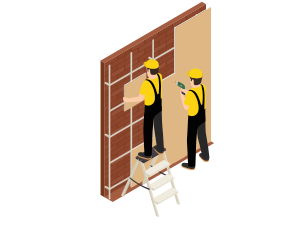Types of Gypsum Board and its Advantages
As we have discussed in earlier scenarios, the construction these days doesn’t involve only bricks, cement and walls. These days, various products and technologies are used in the structure and development of building construction. One such material, which is widely in use is the different types of Gypsum Boards.
Modern construction techniques are continuously evolving day by day and so the demand for building materials surges heavily. There is not a day when construction works won’t happen on the planet. In order to compromise the urgent demands, new tools and techniques are developed every day. One such effective tool is the gypsum boards.
So, What exactly is a Gypsum Boards?
Gypsum board, often known as GWB, wallboard, or drywall, is a typical building material used to finish the inside of walls and ceilings all over the world. It has taken the construction world by storm, as it’s used in 90 % of the construction sites all over the world. It’s usually finished with a range of surface-applied materials like wood, fabric, paint, and plaster.
Due to its incredible fire-resistant capability, it is fondly used in building skyscrapers, institutions and commercial buildings. Gypsum products also provide sound control, fire resistance versatility, quality, and integrity.
Various Types of Gypsum Board
Gypsum boards originally originated from German-Technology, and today there are different types of Gypsum Boards in use across the world. Further, without any due, we take you to the different types of Gypsum Boards used in the market today.
Regular Gypsum Board
On one side, this type of gypsum board is usually white, and on the other, it is brown. This is the most popular sort of gypsum board, as it’s widely utilised in places for commercial purposes. Although all gypsum board is naturally fire resistant, it does not contain any specific additives that make it more fire resistant. Gypsum board panels are typically 4 by 8 feet in size and range in thickness from 3/8 to 1 inch. This is the most common variety among different types of Gypsum Boards, and it comes in four-by-eight-foot panels.
Green Or Moisture Resistant – Gypsum Board
Moisture-resistant gypsum boards, often known as green boards. It has a green covering that makes it more moisture-resistant than conventional gypsum board. Although this is more expensive than standard boards, keep in mind that it is not completely waterproof. Never place these in areas where there is constant water contact since this can erode the boards over time. These boards are commonly determined for the walls of laundry rooms, kitchens, and basements.
Paperless Gypsum Board
Over the last few years, modern technology has improved the conventional gypsum board to make it paperless. This type of board has fibreglass covering instead of paper, which substantially enhances its longevity and resistance to mould and fungus.
It is much easier to cut form to various shapes and sizes than other types of Gypsum Boards, despite being more robust. Paperless gypsum boards have some slight and tough textures on the tops that will require applying joint compounds to achieve a smooth clean finish drywall level.
Type X Gypsum Board
This is what is referred to as a “fire-resistant” gypsum board. To attain a more reliable fire rating, multiple thicknesses concentrations be engaged in layers. It’s more difficult to cut and work with than other types of Gypsum Boards. It’s typically built-in garages, skyscrapers, commercial and apartment complexes where it’s required for safety concerns.
Special noncombustible fibres are used to make Type X gypsum boards. It usually comes in a 5/8-inch thickness, and the additional thickness can help with soundproofing. Installing them in layers to get a higher fire-resistant rating is also a possibility.
Purple Gypsum Boards Or Improved Moisture Resistant Gypsum Boards
Purple gypsum boards have the same benefits as conventional moisture-resistant gypsum boards; but it is more moisture and mould resistant.
It’s suitable for all wall and ceiling applications, and it’s especially well-suited to areas where moisture and decay resistance are sought. This is the one to use if it will come into touch with water surrounding areas.
BLUE Gypsum Board Or Gypsum Board
Plaster baseboard, often known as blue board gypsum boards, is a form of gypsum board used for veneer plastering. Its surface paper has excellent absorption properties, allowing it to absorb plaster-like glue with ease.
It also has excellent water and decay resistance, making it perfect for use as an all-purpose partition board. Blue boards aren’t ideal for dirt, paint, or tape, but they function well in high-moisture locations like bathrooms and kitchens. Furthermore, this type of gypsum board greatly reduces noise when used as room partitions.
Sound Proof Gypsum Boards
Soundproof Gypsum Boards are the trusted and most dependant among the different types of Gypsum Boards.
It is made up of laminated gypsum boards that are made up of a combination of wood fibres, gypsum, and polymers to enhance the STC rating (sound transmission class). Because of these values are more preferred in commercial and professional buildings like hospitals, banks, business constructions, hotels, etc.
As these gypsum boards are denser than conventional regular boards, cutting them may be more difficult. It is utilized in locations where noise is an issue or when complete silence is required in a room because of its soundproofing properties.
Conclusion
Choosing the right gypsum boards among the different types of gypsum boards is made easy, via many applications online. Further, to fully fill the exact demand you possess we are always there to help you via Gypsum Board online.


